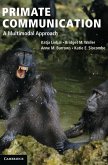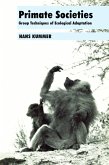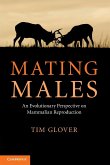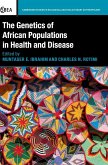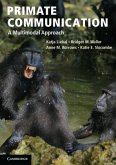- Broschiertes Buch
- Merkliste
- Auf die Merkliste
- Bewerten Bewerten
- Teilen
- Produkt teilen
- Produkterinnerung
- Produkterinnerung
Explores male number variation between and within primate species and its effects on male-female relationships.
Andere Kunden interessierten sich auch für
![Primate Males Primate Males]() M. Kappeler (ed.)Primate Males135,99 €
M. Kappeler (ed.)Primate Males135,99 €![Primate Communication Primate Communication]() Katja LiebalPrimate Communication80,99 €
Katja LiebalPrimate Communication80,99 €![Primate Societies Primate Societies]() Hans KummerPrimate Societies62,99 €
Hans KummerPrimate Societies62,99 €![Primate Socioecology Primate Socioecology]() Lynne A. IsbellPrimate Socioecology49,99 €
Lynne A. IsbellPrimate Socioecology49,99 €![Mating Males Mating Males]() Tim GloverMating Males53,99 €
Tim GloverMating Males53,99 €![The Genetics of African Populations in Health and Disease The Genetics of African Populations in Health and Disease]() The Genetics of African Populations in Health and Disease79,99 €
The Genetics of African Populations in Health and Disease79,99 €![Primate Communication Primate Communication]() Katja LiebalPrimate Communication62,99 €
Katja LiebalPrimate Communication62,99 €-
-
-
Explores male number variation between and within primate species and its effects on male-female relationships.
Hinweis: Dieser Artikel kann nur an eine deutsche Lieferadresse ausgeliefert werden.
Hinweis: Dieser Artikel kann nur an eine deutsche Lieferadresse ausgeliefert werden.
Produktdetails
- Produktdetails
- Verlag: Cambridge University Press
- Seitenzahl: 330
- Erscheinungstermin: 10. Mai 2019
- Englisch
- Abmessung: 246mm x 189mm x 18mm
- Gewicht: 640g
- ISBN-13: 9780521658461
- ISBN-10: 0521658462
- Artikelnr.: 21395504
- Herstellerkennzeichnung
- Libri GmbH
- Europaallee 1
- 36244 Bad Hersfeld
- gpsr@libri.de
- Verlag: Cambridge University Press
- Seitenzahl: 330
- Erscheinungstermin: 10. Mai 2019
- Englisch
- Abmessung: 246mm x 189mm x 18mm
- Gewicht: 640g
- ISBN-13: 9780521658461
- ISBN-10: 0521658462
- Artikelnr.: 21395504
- Herstellerkennzeichnung
- Libri GmbH
- Europaallee 1
- 36244 Bad Hersfeld
- gpsr@libri.de
Preface; Part I. Introduction: 1. The socioecology of primate males:
history and theory Peter M. Kappeler; Part II. Comparative Perspectives on
Male-Female Association: 2. Multi-male breeding groups in birds: ecological
causes and social conflicts Nick B. Davies; 3. Males in macropod society
Peter Jarman; 4. Social counterstrategies against infanticide by males in
primates and other mammals Carel van Schaik; Part III. Variation in Male
Numbers: Taxon-Level Analyses: 5. Causes and consequences of unusual sex
ratios in lemurs Peter M. Kappeler; 6. The number of adult males in
callitrichine groups and its implications for callitrichine social
evolution Eckhard W. Heymann; 7. From binding brotherhoods to short-term
sovereignty: the betwixting dilemma of male Cebidae Karen B. Strier; 8. The
number of males in guenon groups Marina Cords; 9. Socioecology of baboons:
the interaction of male and female strategies Robert A. Barton; 10.
Variation in adult sex ratios of red colobus monkey social groups:
implications for interspecific comparisons Thomas T. Struhsaker; 11. The
number of males in langur groups: monopolizability of females or
demographic process? Elisabeth H. M. Sterck and Jan A. R. A. M. van Hooff;
12. Costs and benefits of the one-male, age-graded and all-male phase in
wild Thomas langur groups Romy Steenbeek, Elisabeth H. M. Sterck, Han de
Vries and Jan A. R. A. M. van Hooff; 13. Male dispersal and mating season
influxes in Hanuman langurs living in multi-male groups Carola Borries; 14.
Rethinking monogamy: the gibbon case Volker Sommer and Ulrich Reichard; 15.
Causes and consequences of variation in male mountain gorilla life
histories and group membership David P. Watts; Part IV. Behavioural Aspects
of Male Coexistence: 16. Relationships among nonhuman primate males: a
deductive framework Jan A. R. A. M. van Hooff; 17. Collective benefits,
free-riders and male extragroup conflict Charles L. Nunn; 18. Dominance,
egalitarianism and stalemate: an experimental approach to male-male
competition in Barbary macaques Signe Preuschoft and Andreas Paul; Part V.
Evolutionary Determinants and Consequences: 19. The evolution of male
philopatry in neotropical monkeys Theresa Pope; 20. Models of outcome and
process: predicting the number of males in primate groups Jeanne Altmann;
21. Why are male chimpanzees more gregarious than mothers? A scramble
competition hypothesis Richard W. Wrangham; 22. Male mating strategies: a
modeling approach Robin I. M. Dunbar; Part VI. Conclusions: 23.
Understanding male primates Michael E. Pereira, Timothy H. Clutton-Brock
and Peter M. Kappeler; References; Index.
history and theory Peter M. Kappeler; Part II. Comparative Perspectives on
Male-Female Association: 2. Multi-male breeding groups in birds: ecological
causes and social conflicts Nick B. Davies; 3. Males in macropod society
Peter Jarman; 4. Social counterstrategies against infanticide by males in
primates and other mammals Carel van Schaik; Part III. Variation in Male
Numbers: Taxon-Level Analyses: 5. Causes and consequences of unusual sex
ratios in lemurs Peter M. Kappeler; 6. The number of adult males in
callitrichine groups and its implications for callitrichine social
evolution Eckhard W. Heymann; 7. From binding brotherhoods to short-term
sovereignty: the betwixting dilemma of male Cebidae Karen B. Strier; 8. The
number of males in guenon groups Marina Cords; 9. Socioecology of baboons:
the interaction of male and female strategies Robert A. Barton; 10.
Variation in adult sex ratios of red colobus monkey social groups:
implications for interspecific comparisons Thomas T. Struhsaker; 11. The
number of males in langur groups: monopolizability of females or
demographic process? Elisabeth H. M. Sterck and Jan A. R. A. M. van Hooff;
12. Costs and benefits of the one-male, age-graded and all-male phase in
wild Thomas langur groups Romy Steenbeek, Elisabeth H. M. Sterck, Han de
Vries and Jan A. R. A. M. van Hooff; 13. Male dispersal and mating season
influxes in Hanuman langurs living in multi-male groups Carola Borries; 14.
Rethinking monogamy: the gibbon case Volker Sommer and Ulrich Reichard; 15.
Causes and consequences of variation in male mountain gorilla life
histories and group membership David P. Watts; Part IV. Behavioural Aspects
of Male Coexistence: 16. Relationships among nonhuman primate males: a
deductive framework Jan A. R. A. M. van Hooff; 17. Collective benefits,
free-riders and male extragroup conflict Charles L. Nunn; 18. Dominance,
egalitarianism and stalemate: an experimental approach to male-male
competition in Barbary macaques Signe Preuschoft and Andreas Paul; Part V.
Evolutionary Determinants and Consequences: 19. The evolution of male
philopatry in neotropical monkeys Theresa Pope; 20. Models of outcome and
process: predicting the number of males in primate groups Jeanne Altmann;
21. Why are male chimpanzees more gregarious than mothers? A scramble
competition hypothesis Richard W. Wrangham; 22. Male mating strategies: a
modeling approach Robin I. M. Dunbar; Part VI. Conclusions: 23.
Understanding male primates Michael E. Pereira, Timothy H. Clutton-Brock
and Peter M. Kappeler; References; Index.
Preface; Part I. Introduction: 1. The socioecology of primate males:
history and theory Peter M. Kappeler; Part II. Comparative Perspectives on
Male-Female Association: 2. Multi-male breeding groups in birds: ecological
causes and social conflicts Nick B. Davies; 3. Males in macropod society
Peter Jarman; 4. Social counterstrategies against infanticide by males in
primates and other mammals Carel van Schaik; Part III. Variation in Male
Numbers: Taxon-Level Analyses: 5. Causes and consequences of unusual sex
ratios in lemurs Peter M. Kappeler; 6. The number of adult males in
callitrichine groups and its implications for callitrichine social
evolution Eckhard W. Heymann; 7. From binding brotherhoods to short-term
sovereignty: the betwixting dilemma of male Cebidae Karen B. Strier; 8. The
number of males in guenon groups Marina Cords; 9. Socioecology of baboons:
the interaction of male and female strategies Robert A. Barton; 10.
Variation in adult sex ratios of red colobus monkey social groups:
implications for interspecific comparisons Thomas T. Struhsaker; 11. The
number of males in langur groups: monopolizability of females or
demographic process? Elisabeth H. M. Sterck and Jan A. R. A. M. van Hooff;
12. Costs and benefits of the one-male, age-graded and all-male phase in
wild Thomas langur groups Romy Steenbeek, Elisabeth H. M. Sterck, Han de
Vries and Jan A. R. A. M. van Hooff; 13. Male dispersal and mating season
influxes in Hanuman langurs living in multi-male groups Carola Borries; 14.
Rethinking monogamy: the gibbon case Volker Sommer and Ulrich Reichard; 15.
Causes and consequences of variation in male mountain gorilla life
histories and group membership David P. Watts; Part IV. Behavioural Aspects
of Male Coexistence: 16. Relationships among nonhuman primate males: a
deductive framework Jan A. R. A. M. van Hooff; 17. Collective benefits,
free-riders and male extragroup conflict Charles L. Nunn; 18. Dominance,
egalitarianism and stalemate: an experimental approach to male-male
competition in Barbary macaques Signe Preuschoft and Andreas Paul; Part V.
Evolutionary Determinants and Consequences: 19. The evolution of male
philopatry in neotropical monkeys Theresa Pope; 20. Models of outcome and
process: predicting the number of males in primate groups Jeanne Altmann;
21. Why are male chimpanzees more gregarious than mothers? A scramble
competition hypothesis Richard W. Wrangham; 22. Male mating strategies: a
modeling approach Robin I. M. Dunbar; Part VI. Conclusions: 23.
Understanding male primates Michael E. Pereira, Timothy H. Clutton-Brock
and Peter M. Kappeler; References; Index.
history and theory Peter M. Kappeler; Part II. Comparative Perspectives on
Male-Female Association: 2. Multi-male breeding groups in birds: ecological
causes and social conflicts Nick B. Davies; 3. Males in macropod society
Peter Jarman; 4. Social counterstrategies against infanticide by males in
primates and other mammals Carel van Schaik; Part III. Variation in Male
Numbers: Taxon-Level Analyses: 5. Causes and consequences of unusual sex
ratios in lemurs Peter M. Kappeler; 6. The number of adult males in
callitrichine groups and its implications for callitrichine social
evolution Eckhard W. Heymann; 7. From binding brotherhoods to short-term
sovereignty: the betwixting dilemma of male Cebidae Karen B. Strier; 8. The
number of males in guenon groups Marina Cords; 9. Socioecology of baboons:
the interaction of male and female strategies Robert A. Barton; 10.
Variation in adult sex ratios of red colobus monkey social groups:
implications for interspecific comparisons Thomas T. Struhsaker; 11. The
number of males in langur groups: monopolizability of females or
demographic process? Elisabeth H. M. Sterck and Jan A. R. A. M. van Hooff;
12. Costs and benefits of the one-male, age-graded and all-male phase in
wild Thomas langur groups Romy Steenbeek, Elisabeth H. M. Sterck, Han de
Vries and Jan A. R. A. M. van Hooff; 13. Male dispersal and mating season
influxes in Hanuman langurs living in multi-male groups Carola Borries; 14.
Rethinking monogamy: the gibbon case Volker Sommer and Ulrich Reichard; 15.
Causes and consequences of variation in male mountain gorilla life
histories and group membership David P. Watts; Part IV. Behavioural Aspects
of Male Coexistence: 16. Relationships among nonhuman primate males: a
deductive framework Jan A. R. A. M. van Hooff; 17. Collective benefits,
free-riders and male extragroup conflict Charles L. Nunn; 18. Dominance,
egalitarianism and stalemate: an experimental approach to male-male
competition in Barbary macaques Signe Preuschoft and Andreas Paul; Part V.
Evolutionary Determinants and Consequences: 19. The evolution of male
philopatry in neotropical monkeys Theresa Pope; 20. Models of outcome and
process: predicting the number of males in primate groups Jeanne Altmann;
21. Why are male chimpanzees more gregarious than mothers? A scramble
competition hypothesis Richard W. Wrangham; 22. Male mating strategies: a
modeling approach Robin I. M. Dunbar; Part VI. Conclusions: 23.
Understanding male primates Michael E. Pereira, Timothy H. Clutton-Brock
and Peter M. Kappeler; References; Index.



